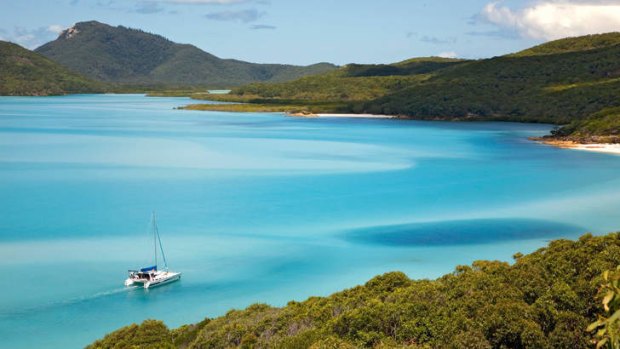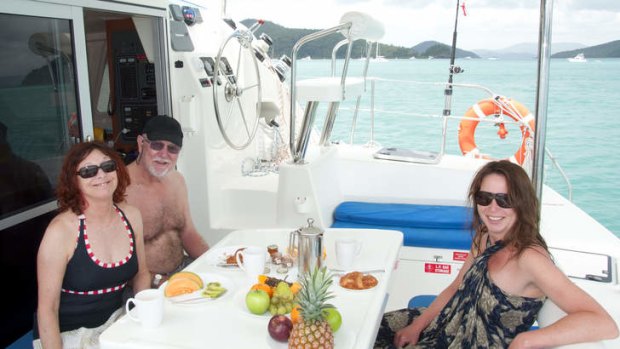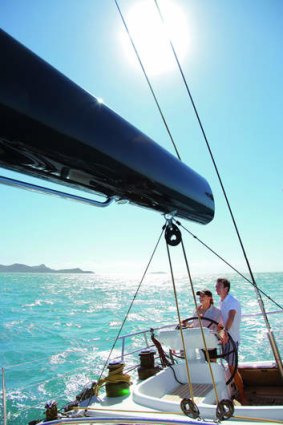This was published 9 years ago
Whitsundays, Queensland: My own sail of the century
By Andrew Bock

Hill Inlet, Whitehaven Beach.Credit: Alamy
Novice skipper Andrew Bock quells a mutinous crew and gets his cat purring in the Whitsundays.
It takes research, recklessness and a certain amount of folly to realise some dreams. My dream was to skipper a yacht through the Whitsunday islands. My folly was to do it just two months after learning to sail.
I encountered hidden reefs along the way, literally. I learned that even in paradise one needs an anchor. But I also proved the dream of sailing a yacht in the tropics is just a few hours away.

Breakfast on board the catamaran.Credit: Andrew Bock
A 2011 study for Yachting Australia found 90 per cent of those who want to sail are not interested in racing or competing.
Like me, they want to enjoy social sailing and cruise in beautiful places. To sail the Whitsunday archipelago and the Great Barrier Reef. Or New Caledonia. Or the islands of Croatia. Or the Caribbean. To journey between the sea and the sky and ride the winds of freedom.
The names of anchorages in the Whitsundays were enough to inspire me. Butterfly Bay and Manta Ray Bay. Dugong Inlet and Blue Pearl Bay.

Sailing in the Whitsunday archipelago.
I had crewed on yachts a long time ago and sailed a few half-days since, but I knew nothing about skippering. I enrolled in a two-day, "Better Sailing" course at Sandringham Yacht Club Boating Academy in Melbourne in winter.
Even in winter, marinas are great places to be. They are ancient travel ports and modern harbours of design. We learnt theory, boat parts and safety procedures indoors, but spent most of our time rigging and sailing a 25-foot yacht on the bay.
We learned new words as well as new skills. Winches and halyards, boom vangs and bowlines, luffs and leeches. Such names seemed pedantic until I was skippering and asked a confused crew member to "loosen that thingy over there".
Our easygoing instructor, Rhan Harris, demonstrated and then let each person skipper or work the sails on tacks, gybes and man-overboard skills.
It was a delight to learn how to read the wind, the gusts and windshadows, and the responses of sails. There is magic in sailing into the force that propels you and beauty in "the first league out from land". Time slows and curves into distance on the geodesic sea. We passed gannets and little penguins that were undisturbed by our quiet craft.
Harris said beginners might take a power-boat-handling course to gain motoring and anchoring skills and a boat licence, then do a Better Sailing course and then practise. "Skippering is about good habits and good practices," he said.
With some waterproof gear, you can also volunteer-crew for as little as $15 a day. It's not expensive for a hobby that can literally take you around the world.
As my departure for the Whitsundays approached, however, I grew nervous. I worried I might scupper more than I skippered and was glad I had invited a friend with sailing experience to join our party of four.
There are six major charter companies and 200 yachts and catamarans for hire in the Whitsundays, with or without a skipper. We chose a catamaran over a monohull and didn't regret it. Catamarans sail evenly, have a shallower draught and twice the entertaining and relaxing area.
We chose Sunsail charters because it is the only company based on Hamilton Island, with transfers from the nearby airport, and has charter operations around the world.
After analysing food and drink options, we chose Whitsunday Provisioning and its platinum food package. A bounty of high-quality fresh seafood, meat, vegetables, herbs, cheeses, cereals, snacks and fruit was delivered to our boat in ice packs and coolboxes.
The foodies in our group were inspired. We dined like kings and queens on the water all week.
Our 38-foot catamaran had twin 29-horsepower engines, four double cabins, an indoor lounge and an outdoor dining area with a solid canopy. A Bose sound system, a gas barbecue and a dinghy on davits turned the Coral Sea into our backyard. Steps off each stern were perfect platforms for swimming in the 24-degree sea, kayaking, paddle boarding and outdoor showers in the morning sun.
"Bareboating" is a misnomer, one friend observed. We had a floating palace and the gentle rocking of the sea turned our beds into cradles for six nights.
We were given a two-hour briefing about the boat by Sunsail, although we later wished we'd asked for more demonstrations. Then we were piloted out of the marina and let loose on the archipelago. We took our time in Fitzalan passage, familiarising ourselves with motor and sail, before heading a relaxed six nautical miles to Cid Harbour.
As we anchored, a ray leapt out of the water. Turtles surfaced, sighed, and breaststroked by.
We had Moreton Bay bugs and prawns and fine wine for dinner, and were joined by a yachtie friend who told us how two whales had surfaced either side of his yacht. The moon set and made fish shapes in the clouds. "I feel like the moonlight is shining across the water just to me," said one friend.
The Whitsundays are Australia's premier cruising destination and suitable for less experienced skippers for several reasons. The sea is sheltered by the Great Barrier Reef. There are anchorages protected from every wind and several have mooring buoys, a blessing for beginners. Charters are limited to an area that encompasses Hayman Island and Lindeman Island in the south, so there is generally a resort marina nearby. Sunsail staff were quick to respond on radio and a support boat is never far away.
The second day we motored north through light northerlies and managed to pick up one of six mooring buoys in time to snorkel and watch the sun set over Blue Pearl Bay. We were immersed in the elements and in colours.
The next morning, one crew member came face-to-face with a 1.5-metre, psychedelic-blue, giant Maori wrasse and a school of yellow-tailed fusiliers. She couldn't stop talking about it.
We reluctantly left Blue Pearl Bay around lunchtime, later than good bareboat skippers should.
With a light tail wind on the third day we experimented with the sails, "goose-winging" and motoring with the jib. That night we anchored in Nara Inlet, flanked on both sides by national park.
We listened to the music of water birds and kookaburras, wind fluting in the rigging and ripples lapping the hull. The water stilled to glass after dark and the deck lights of other yachts painted a coloured calligraphy on the surface.
The next morning we visited 2300-year-old art drawn by the Aboriginal people who began visiting the islands 8000 years before James Cook named the Whitsunday passage in 1770.
We had better navigation aids than Cook, but a charter boat skipper still has to master some ancient skills. Weather and tide forecasting, navigation, anchoring, sailing and the various operating systems of the vessel. It's better to figure out what skills you might lack before departing.
It is possible to navigate by sight using landmarks and sea markers in the Whitsundays. We also used the boat's GPS chart plotter and an indispensable guidebook, supplied with every boat, 100 Magic Miles of the Great Barrier Reef.
We also charted routes using two smartphone apps, Navionics and Windfinder, and occasionally called to get advice from Sunsail.
As I gradually assumed skippering responsibilities, I also began to work harder and harder.
For every action on a boat there is an inverse action. Cleat on, cleat off. Bilge open, bilge closed. Snubber on, snubber off. Between chores, charting and sailing, I didn't find time to sunbake or read. At one point I got tired and began to turn into the grumpy skipper type I abhorred. Fortunately, my diligent and hard-drinking crew mutinied and a sense of indulgence was quickly restored, along with wine and eye fillet steak.
On the fourth day, we sailed south with the tidal current and the wind, silently, effortlessly doing eight knots. This was sailing.
Riding the elements with ease, feeling the wind in the sails and the glide of the boat. But the next morning, after a wind change, our anchor would not come up.
Our chain had wrapped itself around a coral bommie overnight. I dived with a mask but could not see the snag. We were careful, but the chain snapped when we tried to free it. We noted co-ordinates and motored back to Hamilton Island, sails between our legs.
Sunsail fitted a new anchor and chain quickly, and we set sail for Cid Harbour again to shelter from a strengthening south-easterly.
We had circumnavigated Whitsunday Island. It was a short sail for an experienced skipper, but an odyssey for this one. We left much of the archipelago unexplored, but I had sailed and anchored in paradise. I had discovered 100 reasons to sail and only a few to stay on shore. I am already charting my next trip.
The writer sailed with the assistance of Sunsail and Whitsunday Provisioning.
MORE INFORMATION
GETTING THERE
Virgin and Jetstar offer direct flights from Melbourne and Sydney to Hamilton Island.
SAILING THERE
Sunsail charter a 38-foot, eight-berth catamaran for six days from $4475. See sunsail.com.au.
Whitsunday Provisioning supplies basic daily food packages from $28 a person, and platinum packages from $53. See whitprov.com.au.
Best time for sailing the Whitsundays is April to November.
Sign up for the Traveller Deals newsletter
Get exclusive travel deals delivered straight to your inbox. Sign up now.